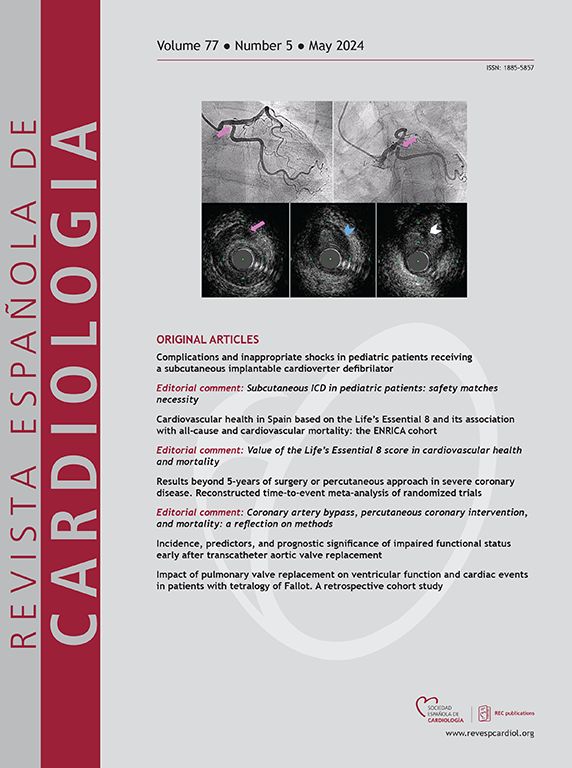使用 HeartLogic ICD 多参数预警对心力衰竭进行远程治疗的临床影响
IF 5.9
2区 医学
Q2 Medicine
引用次数: 0
摘要
导言和目的事实证明,多参数植入式心律转复除颤器 HeartLogic 指数能敏感、及时地预测即将发生的心衰(HF)失代偿。我们评估了护理人员在远程管理警报的基础上实施标准化随访方案的影响。对传输的数据进行远程分析,如果发出警报,则通过电话联系患者。临床行动通过远程或门诊实施。主要终点包括高血压住院或死亡。次要终点为高血压门诊量。我们对采用该方案前后 12 个月的情况进行了比较。结果我们分析了 392 名患者(年龄 69 ± 10 岁,76% 为男性,50% 为缺血性心肌病患者),其中 20% 使用了植入式心律转复除颤器,80% 使用了心脏再同步治疗除颤器。在采用该方案前的 12 个月内,86 名患者(22%)中有 151 次出现主要终点;在采用该方案后的 12 个月内,45 名患者(11%)中有 69 次出现主要终点(P < .001)。每位患者的平均住院次数在采用前为 0.39 ± 0.89 次,采用后为 0.18 ± 0.57 次(P < .001)。采用前,96 名(24%)患者因高血压就诊 185 次,采用后,48 名(12%)患者因高血压就诊 64 次(P < .001)。每位患者的平均就诊次数在采用前为 0.47 ± 1.11 次,采用后为 0.16 ± 0.51 次(P <.001)。结论基于远程管理 HeartLogic 警报的标准化随访方案能够对高血压患者进行有效的远程管理。采用该方案后,我们发现心房颤动住院和门诊就诊人数明显减少。本文章由计算机程序翻译,如有差异,请以英文原文为准。
Impacto clínico del tratamiento a distancia de la insuficiencia cardiaca con la alerta multiparamétrica del DAI HeartLogic
Introduction and objectives
The multiparametric implantable cardioverter-defibrillator HeartLogic index has proven to be a sensitive and timely predictor of impending heart failure (HF) decompensation. We evaluated the impact of a standardized follow-up protocol implemented by nursing staff and based on remote management of alerts.
Methods
The algorithm was activated in HF patients at 19 Spanish centers. Transmitted data were analyzed remotely, and patients were contacted by telephone if alerts were issued. Clinical actions were implemented remotely or through outpatient visits. The primary endpoint consisted of HF hospitalizations or death. Secondary endpoints were HF outpatient visits. We compared the 12-month periods before and after the adoption of the protocol.
Results
We analyzed 392 patients (aged 69 ± 10 years, 76% male, 50% ischemic cardiomyopathy) with implantable cardioverter-defibrillators (20%) or cardiac resynchronization therapy defibrillators (80%). The primary endpoint occurred 151 times in 86 (22%) patients during the 12 months before the adoption of the protocol, and 69 times in 45 (11%) patients (P < .001) during the 12 months after its adoption. The mean number of hospitalizations per patient was 0.39 ± 0.89 pre- and 0.18 ± 0.57 postadoption (P < .001). There were 185 outpatient visits for HF in 96 (24%) patients before adoption and 64 in 48 (12%) patients after adoption (P < .001). The mean number of visits per patient was 0.47 ± 1.11 pre- and 0.16 ± 0.51 postadoption (P < .001).
Conclusions
A standardized follow-up protocol based on remote management of HeartLogic alerts enabled effective remote management of HF patients. After its adoption, we observed a significant reduction in HF hospitalizations and outpatient visits.
求助全文
通过发布文献求助,成功后即可免费获取论文全文。
去求助
来源期刊

Revista espanola de cardiologia
医学-心血管系统
CiteScore
4.20
自引率
13.60%
发文量
257
审稿时长
28 days
期刊介绍:
Revista Española de Cardiología, Revista bilingüe científica internacional, dedicada a las enfermedades cardiovasculares, es la publicación oficial de la Sociedad Española de Cardiología.
 求助内容:
求助内容: 应助结果提醒方式:
应助结果提醒方式:


